Any horse owner will tell you that the cold, wet winter months can be a real headache but what you might not realize is that the summer heat provides its own set of problems that can be just as serious, if not more so. The good news though is that while heatstroke can be, in extreme cases, fatal it can also be easily prevented.
How can you stop a horse overheating? The quickest way of cooling a horse down is to give them access to plenty of fresh water, take them out of direct sunlight, and make sure there’s enough of a breeze to aid the evaporation of the sweat. Together these will help to quickly reduce your horse’s core temperature, therefore cool them down.
What are the signs of a horse overheating?
While all horses are different and will display varying symptoms there are a few common things to look out for.
- Sweating – some horses will sweat profusely while other will sweat less.
- Skin temperature – typically the will be hot but in extreme cases can be cold.
- Muscle weakness – some horses will appear lethargic and slow to move
- Dehydration – skin less elastic, eyes appear sunken, dry or tacky gums and urinate less.
- Change in vital signs – if your horse’s vital signs increase it can be a strong sign that they’re overheating.
| Vital sign | Normal | Heat stress | Heatstroke |
|---|---|---|---|
| Rectal temp | 98.5 to 101°F (36.9 to 38.3°C) at rest Up to 103°F (39.4°C) at work | 103°F (39.4) to 105°F (39.4 to 40.5°C) | > 105°F (40.5°C) |
| Pulse | 30 to 44 (beats per minute) | 50 to 60 | > 60 |
| Breathing | 8 to 12 (breaths per minute) | 20 to 40 | > 40 |
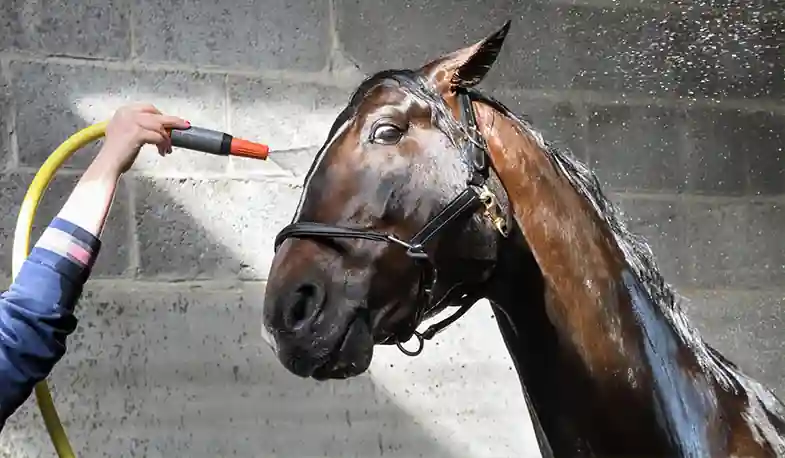
What causes a horse to overheat?
You might think that a horse will overheat if they’re over-exercised or the weather is really hot, but while this is obviously true it’s not the only cause of a horse overheating. There are conditions, such as Equine Cushing’s Disease, that can increase a horse’s chances of overheating but the main reasons a horse can overheat are:
- Hot weather, especially when there’s no shade
- High humidity, especially when there’s no breeze
- Poor ventilation (either when stalled or when transported)
- Prolonged exposure to direct sunlight
- Excessive workload without rest
- Transportation without regular breaks
- Overweight or obesity
There’s rarely just one cause for a horse overheating though, for example in hot, humid conditions it can take a healthy horse in moderate exercise less than 20 minutes to raise its temperature to dangerous levels. This is around 10 times faster than humans which is why it’s so important to keep your horse as cool as you can.
How to keep your horse cool
Horses are very good at reducing their body temperature naturally by sweating but this can sometimes be difficult for them to do (especially if the weather is hot and humidity is high) which is why we need to help them.
1) Give your horse plenty of cool water
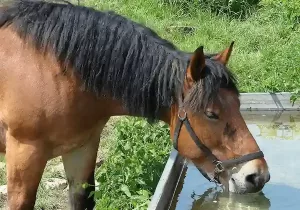
The importance of allowing your horse access to plenty of clean, fresh water all of the time can never be overestimated, and giving your horse cold water to drink will not only help to keep him cool (as well as help to cool him down) but will also help him to stay hydrated. Ideally, the water should be between 45 and 65°F (7.2 and 18.3°C) to give the best cooling effect.
On an ‘average’ day (normal climate and normal horse temperature) horses can drink somewhere between 6 and 10 gallons of water every day so make sure your horse has enough water when the weather is hotter and the humidity higher and when he’s hot too.
Some people may argue that you shouldn’t give a hot horse water straight away and that you should allow them to cool down first but this simply isn’t the case. Rather than withholding water you should allow him to drink straight away, and let him drink as much as he wants to. A horse’s stomach can take up to 4 gallons of water at any one time so there’s very little chance of your horse drinking too much, after all, horses know when they’ve drunk too much water and will stop.
2) Make sure your horse has plenty of shade
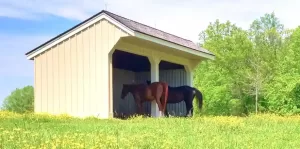
Horses need shade for a number of reasons, not only will it help to protect them against getting sunburnt but it will help them to keep cool. This works because the air generally is much cooler in the shade and that helps to remove the hot air from your horse by replacing it with cooler air. Known as convection cooling, this is one of the most effective methods for staying cool and is how air conditioning works.
For a shelter to offer the best level of shading and cooling it should be completely open on one side and have a window (even a simple hole will work) on the opposite side so that the air can flow through. The open side should also be facing away from the midday sun (either north or south so that it never gets direct sunlight) so that the shelter can stay cool.
3) A cool breeze can effectively cool your horse
While shade can work well to keep your horse cool, using a breeze (either natural or artificial) can really help to cool a hot horse down after exercise. If you’re not able to set a portable fan in your horse’s stall then walking him around gently will have the same effect. This is because as your horse moves the air around him is disturbed and therefore works to wick the sweat away much quicker.
4) Hose your horse down
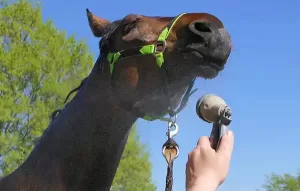
If your horse is sweating then you can use a hose to cool him down quickly, so long as the temperature of the water is lower than that of your horse’s body. The water itself will help to remove the sweat while the temperature of it will also help to stop your horse from sweating as well as reduce his overall body temperature.
There’s a popular misconception that hosing a hot horse down will cause illness but studies have proven that this just isn’t true. In fact, research has shown that the colder the water the more heat will be lost from your horse’s body and therefore the cooler he’ll be. Just make sure the water isn’t too cold otherwise your horse will start to shiver and will need to be warmed up.
5) Misting fans
A relatively new invention and one employed to keep most Olympic horses cool, misting fans work by spraying a fine mist into the air while at the same time using a fan to create a gentle breeze (that will drop the ambient temperature by between 20 and 30°F). These are great for cooling horses because not only does the cool mist help to lower your horse’s body temperature but the breeze will improve evaporation and convection, therefore cooling your horse in record time.
If you don’t already have a mist fan, you can pick them up relatively cheaply on Amazon, just make sure you either choose one that is battery powered or if you buy one with a cable that you can put it out of reach of your horse.
6) Clip your horse’s coat
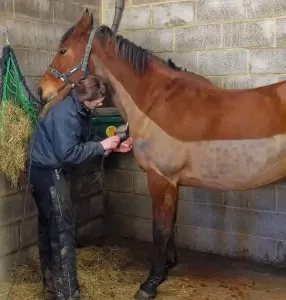
Many people think about clipping their horse during the winter but don’t even consider doing it during the summer. Yet do this will mean that when your horse sweats the evaporation will happen directly on his skin rather than on his hair. This might not sound like it’ll make much of a difference but can be far more effective than you realize.
If you’re not sure how to clip your horse or just want to know more about when and why you should clip a horse then you should check out this article I wrote explaining everything you need to know.
7) Change when and how much your ride
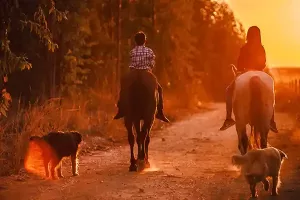
Riding when the sun is at its hottest will not only cause problems for your horse (in terms of the temperature and overheating) but will also do the same for you. You’ll both suffer greatly from the heat and will run the risk of either (or both) of you suffering from heat stress or, in extreme cases, heatstroke.
This is why, if you can, you should avoid riding (or any strenuous exercise) when the temperature and relative humidity are over 150. If, however, for whatever reason you’re unable to do this then try and ride early in the morning or late at night and keep the workload light. It’s also important to stop regularly so your horse can cool down and regain his normal breathing rate. Working your horse in the shade if possible and with a breeze (using fans if necessary) will also help to keep him cool and stop him overheating.
8) Turn your horse out when it’s cooler
It’s easy to get in the habit of turning your horse out in the morning after you’ve fed him and before you head off to work but by doing this you run the risk of your horse being outside when the sun is at its highest (and therefore hottest). Instead, try and change when you turn him out and when he’s inside.
If possible turn your horse out early in the morning (bringing him in at around 11 am) as well as late evening or even overnight. While the air may well still be hot the ambient temperature will be much cooler.
9) Replace salts lost through sweating
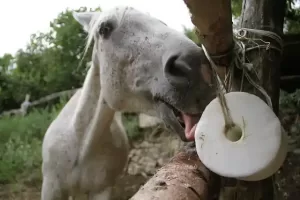
Just like us horses lose salts when they sweat and, while you might not think that matters, these need to be replaced in order for your horse’s body to work properly and better retain water (which will help to cool them down). When you consider that a horse can lose somewhere between 2 and 4 gallons of sweat an hour (if they’re working hard and the temperature is high) you can easily see why it’s so important to make sure you replace the salt they’ve lost.
It’s not a simple as just giving your horse a load more salt and hoping for the best because too much salt can lead to excessive thirst which has its own set of problems. Instead, you need to replace the amount that your horse has lost, but if you don’t know how much your horse has lost the table below will give you an idea of how much salt your horse needs in normal conditions as well as how much extra they’ll need after exercise.
| Condition | Quantity of salt |
|---|---|
| Winter | 1 ounce per day |
| Summer | 2 ounce per day |
| Light workload (low sweating) | Extra ounce per hour of work |
| Normal workload (moderate sweating) | Extra 2 ounces per hour of work |
| High workload (heavy sweating) | Extra 3 ounces per hour of work |
While you can give your horse a salt block it’s better to add loose salt to the meal instead. Feeding it like this will help you to know how much you’re giving them but, because many salt blocks are also made for cattle (which have rougher tongues) it’ll be kinder to your horse and less likely to make his tongue sore.
Some people insist on giving horses electrolytes after exercise instead of just salt but, while this can be good in some cases, most electrolyte supplements don’t contain enough salt (or sodium). Instead, it’s better to address your horse’s salt levels then use electrolytes if necessary. In terms of electrolytes, horses need around 3.1 grams of sodium for every liter of sweat as well as 1.6 grams of potassium, 5.5 grams of chloride, and 0.05 grams of magnesium for every liter.
10) Transport your horse during the coolest part of the day
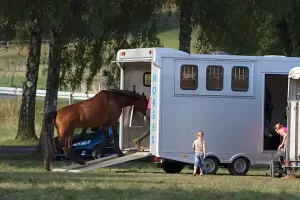
If you have to haul your horse regularly then doing so during the coolest part of the day can make a big difference to your horse’s comfort levels. You should also make sure your trailer is well ventilated so that your horse has a breeze flowing through while you’re on the road.
It’s also important to stop regularly so that your horse can stretch his legs and have a drink. When you do stop though (regardless of whether or not you unload your horse) you should avoid parking in direct sunlight so that the trailer doesn’t heat up more than necessary.
How do you cool a horse with anhidrosis?
Often referred to as non-sweaters some horses (particularly those in hotter climates) have a condition known as anhidrosis which means they aren’t able to produce sweat or produce very little. This can be a very serious condition and, if not managed properly, can prove fatal because the horse is unable to naturally cool itself down after exercise or if the weather is hot and humid.
Related questions
How do horses cool themselves down?
Horses cool themselves down by removing the heat from their body as quickly as they can. They do this by expelling hot air from their lungs when they breathe and while this is effective it’ll only get rid of a certain amount of heat. The rest of the heat is removed by sweat through their skin (via the sweat glands they have throughout their bodies). As the sweat reaches the skin the air wicks that away by means of evaporation which helps to cool them down.
What should you do if your horse is suffering from heatstroke?
If you suspect your horse has heatstroke it’s imperative you call the vet immediately and then start the process of cooling them down while you’re waiting. Studies have shown that ice baths are the most effective (and quickest) way of cooling a horse with heatstroke. Don’t apply ice directly to your horse’s hindquarters but instead apply it to the areas where the blood vessels are more pronounced (such as around the head, neck, back, and ribs).
NEVER use a blanket or sheet on a horse you suspect of having heatstroke because this will only prevent the sweat from evaporating and therefore will make it harder for them to cool down.
Further reading
- Why do horses wear masks?
- Is wet grass okay for horses?
- Keep your horse warm in winter
- Is your horse getting enough water?
- How much space do horses need?
- Beginner’s guide to horse care
- Do horses really need shoes?
- Stop mosquitoes bothering your horse
- Prepare your horse for hurricane season
- Help your horse deal with fireworks.
I hope you found this article helpful. If you did I’d be grateful if you could share it please as it would really help me.
Recommended products
Over the years I have tried hundreds of different horsey products, from various blankets and halters to different treats. Some I’ve loved, others I’ve hated but I thought I’d share with you my top all-time favorite products, the ones I never leave the yard without. I’ve included links to the products (which are in no particular order) that I really think are great.
- Horse Knots by Reference Ready – If you’re like me and enjoy pocket reference guides then you’ll love this knot tying guide. These handy cards can easily fit in your pocket or attach to the saddle for quick reference. They’re waterproof, durable and are color coded to make them easy to follow.
- Mane ’n Tail Detangler – Even if you never show your horse you’ll need to detangle his tail from time to time (and possibly his mane too) which is always a challenging chore! I’ve found that if I run a little bit of detangler through my horse’s tails every few days it stops them from getting matted up and makes combing them easy, even if they’re coated in mud. I don’t know if I should admit to this or not but it also works wonders on my hair.
- TAKEKIT Pro clippers – Over the years I’ve tried a lot of different clippers and while some were obviously better than others I found these to be by far the best. They are heavier than a lot of other clippers but for me, that’s a good thing, it makes them feel more sturdy and hardwearing. On top of that they have a range of speeds so are just as good for clipping your horse’s back as they are his face. I also like the fact that they come in a handy carry case but that’s not for everybody. The company that makes them is super good and incredibly helpful too, a real bonus these days. The only thing I wasn’t keen on was the fact that it doesn’t come with any oil, but that’s not a major problem as it’s not difficult to buy lubricant.
- Shire’s ball feeder – There are so many boredom buster toys out there but I like to use these every day, regardless of whether or not my horses are bored. I find that it helps to encourage my horses to problem solve by rewarding them with treats (or pieces of fruit) but it also mimics their natural grazing behavior which helps to keep them calm and de-stressed.
- Horse safe mirror – This is a strange one that many people are surprised about but I like to put horse safe mirrors in the trailers as well as in the quarantine stalls. It helps to prevent the feeling of isolation by giving the impression of other horses being around. Being herd animals horses can get extremely stressed when they feel that they’re on their own but with these stick-on mirrors, they believe that at least one other horse is with them.
- Rectal thermometer – I know this isn’t glamourous at all but it’s vital for your horse’s well-being to be able to check their temperature and a rectal thermometer is the easiest way of doing this which is why I’ve added it to the list.
Shopping lists
I’ve also put together a few shopping lists of essential items that I’ve found helpful over the years. I’ve broken the lists down into different categories rather than put everything in one massive list 😉

